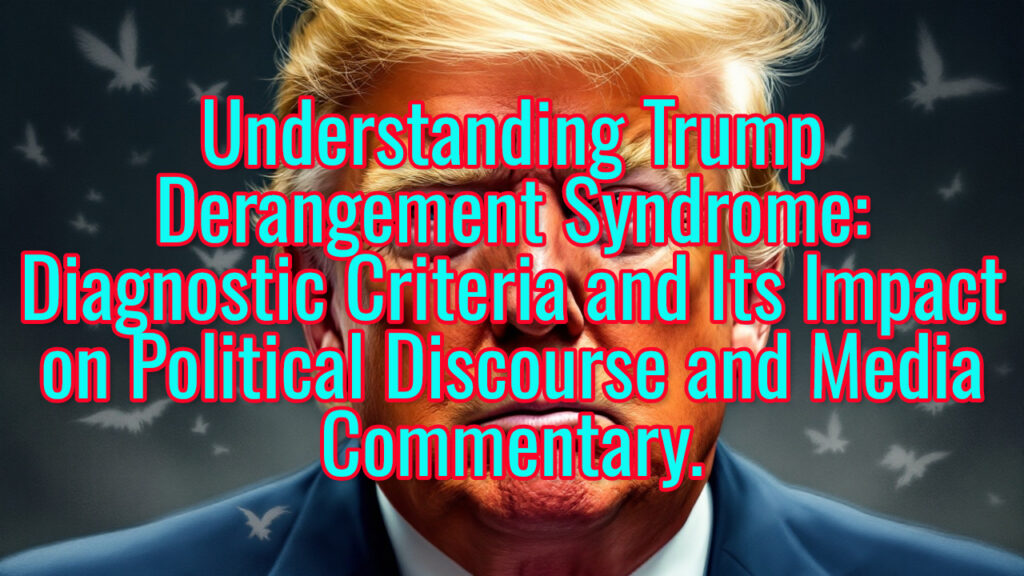Introduction to Trump Derangement Syndrome (TDS)
Trump Derangement Syndrome (TDS) is a phenomenon in which individuals exhibit extreme emotional responses to Donald Trump, often leading to irrational interpretations of his actions and statements. This syndrome has been characterized by distinct stages, each marked by increasing obsession and disconnection from reality.
Diagnostic Criteria for TDS
The key symptom of TDS is a tendency to interpret everything Trump says or does in a hostile and exaggerated light. For instance, a benign statement can be twisted into a harmful interpretation, showcasing a pattern of bad-faith reasoning. This is evident in media portrayals where Trump’s comments are taken out of context to create sensational headlines, reflecting a primary cause of TDS’s sensationalist media environment.
Stages of TDS
TDS can be observed in three stages.
- Stage One involves an initial dislike of Trump, which may not yet manifest as TDS. However, individuals may begin to engage in bad-faith arguments against him, often ignoring factual context.
- Stage Two sees a heightened obsession with Trump. Individuals frequently reference him in unrelated discussions, demonstrating a compulsive need to voice their negative opinions.
- Stage Three is characterized by a complete disconnection from reality, resulting in individuals forming beliefs based on imaginary scenarios rather than factual occurrences, such as fears of Trump initiating mass persecution of specific groups.

Media Influence and Confirmation Bias
The media plays a significant role in perpetuating TDS by focusing disproportionately on Trump’s actions, often framing them through a lens of negativity. This creates an environment where confirmation bias thrives; individuals who dislike Trump seek out information that reinforces their beliefs, leading to an echo chamber effect. Consequently, even legitimate criticism of Trump can overshadow hyperbolic claims that detract from meaningful discourse.
Potential Treatments for TDS
Addressing TDS requires a nuanced approach. One method encourages individuals to reflect on Trump’s first term, highlighting that many predicted catastrophic outcomes did not materialize. Another option is to avoid discussions about Trump altogether, allowing time for individuals to reassess their views without triggering their emotional responses. Ultimately, engaging with TDS in online spaces can serve as entertainment, but in personal interactions, the best strategy may be to step back and refrain from confrontation.
Conclusion
Understanding TDS involves recognizing its symptoms and the implications of media influence and personal biases. By promoting rational discourse and addressing misconceptions, it is possible to navigate the complexities of political discussions surrounding Trump’s presidency.
Key Insights
Definition of Trump Derangement Syndrome (TDS)
- TDS refers to individuals exhibiting extreme emotional responses to Donald Trump, interpreting his statements and actions in a highly negative and irrational manner.
- This syndrome is characterized by a tendency to misinterpret Trump’s words or actions, often attributing sinister motives without a reasonable basis.
- Identifying TDS requires using “bad faith” interpretations, where individuals intentionally distort meanings to fit their narrative.
Stages of TDS
- Stage Zero: Disliking Trump without exhibiting TDS symptoms; individuals may hold negative opinions but maintain a level of rational discourse.
- Stage One: Bad faith arguments and interpretations begin to surface, where individuals start ignoring factual contexts and engage in extreme exaggerations of Trump’s statements.
- Stage Three: Complete disconnection from reality occurs, leading to irrational fears and delusions, such as believing that Trump intends to enact policies without a factual basis.
Media Influence on TDS
- Mainstream media plays a significant role in amplifying TDS by sensationalizing Trump’s remarks and actions to attract viewership, often omitting context.
- The tendency for media outlets to report on Trump’s statements in a biased manner contributes to the public’s distorted perceptions, leading to a cycle of confirmation bias among those with TDS.
- The “orange man bad” narrative becomes pervasive, overshadowing any potential constructive criticism of Trump’s policies.
Psychological Projection and Confirmation Bias
- Individuals suffering from TDS often project their extreme views onto Trump supporters, assuming they share the same irrational beliefs or motivations.
- This projection can manifest in labeling all Trump supporters as complicit in alleged harmful ideologies, further deepening societal divisions.
- Confirmation bias reinforces their beliefs as they seek information that aligns with their negative perceptions of Trump and ignores opposing viewpoints.

Treatment Approaches for TDS
- Objective Evidence: Pointing to factual outcomes from Trump’s first term can help mitigate fears and provide a more balanced perspective for those with lower stages of TDS.
- Avoidance: In cases of advanced TDS, avoiding discussions about Trump may prevent triggering further episodes of irrationality.
- Entertainment Perspective: Viewing TDS-related content on social media as entertainment can provide a lighter approach, easing the tension surrounding political discourse.
Thanks For Reading
Steven G Smith






More Stories
Examining the rise and controversies surrounding gender ideology, focusing on its impact on society and traditional definitions of gender.
Canada’s DIRTY SECRET Makes Annexation Inevitable
Examining the Causes and Consequences of the Devastating LA Fires Amidst Leadership Shortcomings and Public Neglect.